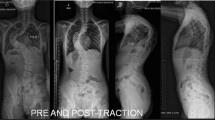Abstract
Purpose
To present a case series of 6 patients with Neurofibromatosis type 1 (NF-1) who had severe kyphoscoliosis with vertebral dislocation, and were treated with halo-pelvic traction (HPT) and posterior fusion. To discuss the pathological characteristics of this rare entity, and report our experience using HPT to manage the condition.
Methods
From March, 2016 to September, 2017, 6 patients with severe kyphoscoliosis with vertebral dislocation were admitted for HPT and posterior surgery, and were followed for 2 years.
Results
The 6 patients received HPT for an average of 42 days. The average scoliosis Cobb angle was 131.2° before HPT, 69.9° after HPT, 52.7° after posterior surgery, and 51.7° at the 2-year follow-up. The average 2-year correction rate was 61.7%. The average kyphosis Cobb angle was 125.2° before HPT, 62.9° after HPT, 62.2° after posterior surgery, and 64.9° at the 2-year follow-up. The average 2-year correction rate was 46.5%. Proximal screw pull-out was found in one patient at the 3-month follow-up visit, but revision surgery was not needed. No patients experienced permanent neurological deficits or death. No screw malposition occurred in any patient.
Conclusion
HPT is a viable treatment option for vertebral dislocation in NF-1. After 6 weeks of traction, the vertebral dislocation, scoliosis, and kyphosis can be dramatically reduced, and thus the conditions for corrective surgery can be improved.



Similar content being viewed by others
Abbreviations
- NF-1:
-
Neurofibromatosis type 1
- HPT:
-
Halo-pelvic traction
References
Jia F, Cui X, Wang G, Liu X, Sun J (2019) Spontaneous rotational dislocation of the lumbar spine in type 1 neurofibromatosis: a case report and literature review. Medicine 98(16):e15258
Kandwal P, Vijayaraghavan GP, Nagaraja UB, Jayaswal A (2017) Severe rigid scoliosis: review of management strategies and role of spinal osteotomies. Asian Spine J 11(3):494–503
Mehrpour S, Sorbi R, Rezaei R, Mazda K (2017) Posterior-only surgery with preoperative skeletal traction for management of severe scoliosis. Arch Orthop Trauma Surg 137(4):457–463
Nakamura H, Kudo T, Kobayashi H, Taguchi Y (2018) Successfully treated traumatic dislocation of a thoracic vertebra caused by minor trauma in a patient with neurofibromatosis type I a case report and literature review. NMC Case Rep J 5(4):77–81
Tsirikos AI, Dhokia R, Wordie S (2018) Rotatory Dislocation of the Spine in Dystrophic Kyphoscoliosis secondary to neurofibromatosis type 1. J Central Nerv Syst Dis 10:1179573518819484
Hanna BG, Pill SG, Drummond DS (2002) Irreducible thoracic spondyloptosis in a child with neurofibromatosis: a rationale for treatment. Spine 27(14):E342–E347
Cho SK, Stoker GE, Bridwell KH (2011) Spinal reconstruction with pedicle screw-based instrumentation and rhBMP-2 in patients with neurofibromatosis and severe dural ectasia and spinal deformity: report of two cases and a review of the literature. J Bone Jt Surg 93(15):e86
Meneses-Quintero D, Alvarado-Gomez F, Alcala-Cerra G (2015) Dystrophic thoracic spine dislocation associated with type-1 neurofibromatosis: case report and rationale for treatment. J Craniovertebral Junction Spine 6(2):79–82
Lee J, Kawakami N, Tauchi R, Kawakami K, Ohara BT (2019) Surgical treatment of neurofibromatosis-1 with anterior-posterior fusion and concave strut graft for dystrophic kyphoscoliosis with dislocation: a case report with 10-year follow up. J Orthop Surg Tech 2(1):74–79
Author information
Authors and Affiliations
Corresponding author
Ethics declarations
Conflict of interest
We declare that we have no financial and personal relationships with other people or organizations that can inappropriately influence our work, there is no professional or other personal interest of any nature or kind in any product, service and/or company that could be construed as influencing the position presented in, or the review of, the manuscript entitled.
Additional information
Publisher's Note
Springer Nature remains neutral with regard to jurisdictional claims in published maps and institutional affiliations.
Rights and permissions
About this article
Cite this article
Wang, Y., Li, C., Liu, L. et al. Halo-pelvic traction for thoracic spine dislocation in neurofibromatosis type 1: a case series. Arch Orthop Trauma Surg 142, 571–577 (2022). https://doi.org/10.1007/s00402-020-03634-w
Received:
Accepted:
Published:
Issue Date:
DOI: https://doi.org/10.1007/s00402-020-03634-w




